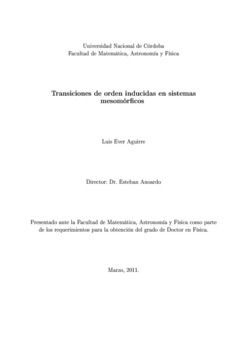| dc.contributor.advisor | Anoardo, Esteban | es |
| dc.contributor.author | Aguirre, Luis Ever | es |
| dc.date.accessioned | 2011-09-06T15:27:32Z | |
| dc.date.available | 2011-09-06T15:27:32Z | |
| dc.date.issued | 2011-03 | es |
| dc.identifier.citation | Incluye referencias bibliográficas: p. 114-119. | es |
| dc.identifier.uri | http://hdl.handle.net/11086/162 | |
| dc.description | Tesis (Doctor en Física)--Universidad Nacional de Córdoba. Facultad de Matemática, Astronomía y Física, 2011. | es |
| dc.description.abstract | Experimentos realizados en celdas electro-ópticas sometidas a la aplicación de tensiones alternas (AC) y continuas (DC), conducen a resultados escasamente explorados en la literatura y jamás explicados de manera consistente. Particularmente, se observan patrones celulares que, bajo ciertas condiciones, evolucionan a patrones hexagonales.
Teniendo en cuenta que la aplicación de tensiones alternas (AC) y continuas (DC), dan lugar a efectos que pueden ser relevantes en la formación de estas estructuras: inyección de cargas desde los electrodos, separación de cargas, interacciones flexoeléctricas, inestabilidades convectivas, etc, estos efectos fueron analizados a fin de determinar su importancia en la formación de las mencionadas estructuras. También se destaca la importancia de la presencia de un campo DC en la formación de las estructuras observadas, sugiriendo que posibles efectos flexo-eléctricos también deben tomarse en cuenta al momento de analizar las estructuras
conseguidas. | es |
| dc.description.abstract | Recent nuclear magnetic resonance (NMR) experiments suggest the possibility
of order transitions in a nematic liquid crystal (5CB), as induced
by the simultaneous action of an acoustic and a magnetic elds. The order
tansition manifests as a structure, pattern or a defect network within the
volume. An inherent problem of the NMR set-up is related to the di culty
in observing, by optical methods, the changes induced in the sample volume
during the experiment. In order to overcome this limitation, the problem was
tackled within an electro-optical cell, thus having full access to optical microscopy
techniques. This approach allows a direct observation of structures,
even at a three-dimensional environment. In this context and, by considering
the equivalence among the elastic, electric and acoustic torques, a series of
experiments were performed using electro-optic cells with surface treatment
subjected to electric excitation, gradually increasing their thickness in order
to scan from a two-dimensional regime (2D) to a three-dimensional one (3D).The study revealed, especially in a 3D environment, the importance of
the joint action of an alternate (AC) and continuous (DC) excitation, a case
barely mentioned in the literature. Cellular structures were obtained in 5CB,
that under certain particular conditions, evolve into a hexagonal pattern. Based
on the experimental design and the observed behavior, we conclude that
these structures are not dissipative. In 2D environment, a pattern formation
possible due to
exoelectric interaction was observed in 5CB. | en |
| dc.format.extent | 119 hojas | es |
| dc.language.iso | spa | es |
| dc.rights | Atribución-NoComercial-SinDerivadas 2.5 Argentina | * |
| dc.rights.uri | http://creativecommons.org/licenses/by-nc-nd/2.5/ar/ | * |
| dc.subject | Liquid crystals | en |
| dc.subject | Orientational order of liquids crystals | en |
| dc.subject | Surface phenomena | en |
| dc.subject | Electrooptical effects | en |
| dc.subject.other | Fase nemática | es |
| dc.subject.other | Cristales líquidos | es |
| dc.subject.other | Patrón hexagonal | es |
| dc.subject.other | Patrón celular | es |
| dc.subject.other | Campo eléctrico | es |
| dc.subject.other | Flexoelectricidad | es |
| dc.title | Transiciones de orden inducidas en sistemas mesomórficos | es |
| dc.type | doctoralThesis | es |





